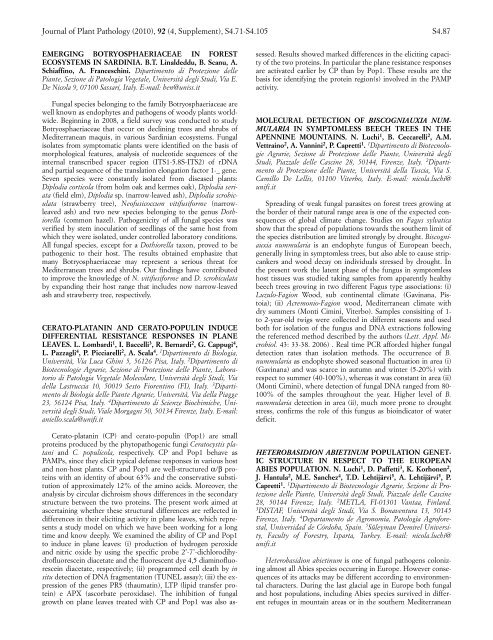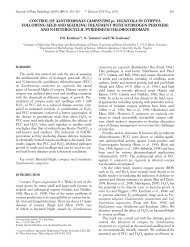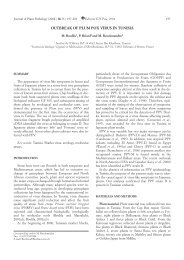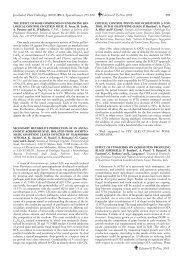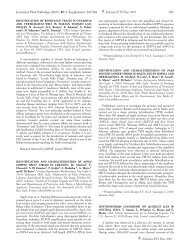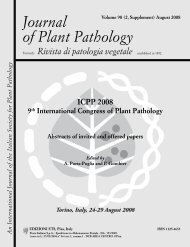Journal of Plant Pathology (2010), 92 (4, Supplement ... - Sipav.org
Journal of Plant Pathology (2010), 92 (4, Supplement ... - Sipav.org
Journal of Plant Pathology (2010), 92 (4, Supplement ... - Sipav.org
You also want an ePaper? Increase the reach of your titles
YUMPU automatically turns print PDFs into web optimized ePapers that Google loves.
<strong>Journal</strong> <strong>of</strong> <strong>Plant</strong> <strong>Pathology</strong> (<strong>2010</strong>), <strong>92</strong> (4, <strong>Supplement</strong>), S4.71-S4.105 S4.87<br />
EMERGING BOTRYOSPHAERIACEAE IN FOREST<br />
ECOSYSTEMS IN SARDINIA. B.T. Linaldeddu, B. Scanu, A.<br />
Schiaffino, A. Franceschini. Dipartimento di Protezione delle<br />
Piante, Sezione di Patologia Vegetale, Università degli Studi, Via E.<br />
De Nicola 9, 07100 Sassari, Italy. E-mail: ben@uniss.it<br />
Fungal species belonging to the family Botryosphaeriaceae are<br />
well known as endophytes and pathogens <strong>of</strong> woody plants worldwide.<br />
Beginning in 2008, a field survey was conducted to study<br />
Botryosphaeriaceae that occur on declining trees and shrubs <strong>of</strong><br />
Mediterranean maquis, in various Sardinian ecosystems. Fungal<br />
isolates from symptomatic plants were identified on the basis <strong>of</strong><br />
morphological features, analysis <strong>of</strong> nucleotide sequences <strong>of</strong> the<br />
internal transcribed spacer region (ITS1-5.8S-ITS2) <strong>of</strong> rDNA<br />
and partial sequence <strong>of</strong> the translation elongation factor 1-_ gene.<br />
Seven species were constantly isolated from diseased plants:<br />
Diplodia corticola (from holm oak and kermes oak), Diplodia seriata<br />
(field elm), Diplodia sp. (narrow-leaved ash), Diplodia scrobiculata<br />
(strawberry tree), Ne<strong>of</strong>usicoccum vitifusiforme (narrowleaved<br />
ash) and two new species belonging to the genus Dothiorella<br />
(common hazel). Pathogenicity <strong>of</strong> all fungal species was<br />
verified by stem inoculation <strong>of</strong> seedlings <strong>of</strong> the same host from<br />
which they were isolated, under controlled laboratory conditions.<br />
All fungal species, except for a Dothiorella taxon, proved to be<br />
pathogenic to their host. The results obtained emphasize that<br />
many Botryosphaeriaceae may represent a serious threat for<br />
Mediterranean trees and shrubs. Our findings have contributed<br />
to improve the knowledge <strong>of</strong> N. vitifusiforme and D. scrobiculata<br />
by expanding their host range that includes now narrow-leaved<br />
ash and strawberry tree, respectively.<br />
CERATO-PLATANIN AND CERATO-POPULIN INDUCE<br />
DIFFERENTIAL RESISTANCE RESPONSES IN PLANE<br />
LEAVES. L. Lombardi 1 , I. Baccelli 3 , R. Bernardi 2 , G. Cappugi 4 ,<br />
L. Pazzagli 4 , P. Picciarelli 2 , A. Scala 4 . 1 Dipartimento di Biologia,<br />
Università, Via Luca Ghini 5, 56126 Pisa, Italy. 2 Dipartimento di<br />
Biotecnologie Agrarie, Sezione di Protezione delle Piante, Laboratorio<br />
di Patologia Vegetale Molecolare, Università degli Studi, Via<br />
della Lastruccia 10, 50019 Sesto Fiorentino (FI), Italy. 3 Dipartimento<br />
di Biologia delle Piante Agrarie, Università, Via della Piagge<br />
23, 56124 Pisa, Italy. 4 Dipartimento di Scienze Biochimiche, Università<br />
degli Studi, Viale M<strong>org</strong>agni 50, 50134 Firenze, Italy. E-mail:<br />
aniello.scala@unifi.it<br />
Cerato-platanin (CP) and cerato-populin (Pop1) are small<br />
proteins produced by the phytopathogenic fungi Ceratocystis platani<br />
and C. populicola, respectively. CP and Pop1 behave as<br />
PAMPs, since they elicit typical defense responses in various host<br />
and non-host plants. CP and Pop1 are well-structured α/β proteins<br />
with an identity <strong>of</strong> about 63% and the conservative substitution<br />
<strong>of</strong> approximately 12% <strong>of</strong> the amino acids. Moreover, the<br />
analysis by circular dichroism shows differences in the secondary<br />
structure between the two proteins. The present work aimed at<br />
ascertaining whether these structural differences are reflected in<br />
differences in their eliciting activity in plane leaves, which represents<br />
a study model on which we have been working for a long<br />
time and know deeply. We examined the ability <strong>of</strong> CP and Pop1<br />
to induce in plane leaves: (i) production <strong>of</strong> hydrogen peroxide<br />
and nitric oxide by using the specific probe 2’-7’-dichlorodihydr<strong>of</strong>luorescein<br />
diacetate and the fluorescent dye 4,5 diamin<strong>of</strong>luorescein<br />
diacetate, respectively; (ii) programmed cell death by in<br />
situ detection <strong>of</strong> DNA fragmentation (TUNEL assay); (iii) the expression<br />
<strong>of</strong> the genes PR5 (thaumatin), LTP (lipid transfer protein)<br />
e APX (ascorbate peroxidase). The inhibition <strong>of</strong> fungal<br />
growth on plane leaves treated with CP and Pop1 was also as-<br />
sessed. Results showed marked differences in the eliciting capacity<br />
<strong>of</strong> the two proteins. In particular the plane resistance responses<br />
are activated earlier by CP than by Pop1. These results are the<br />
basis for identifying the protein region(s) involved in the PAMP<br />
activity.<br />
MOLECURAL DETECTION OF BISCOGNIAUXIA NUM-<br />
MULARIA IN SYMPTOMLESS BEECH TREES IN THE<br />
APENNINE MOUNTAINS. N. Luchi 1 , B. Ceccarelli 2 , A.M.<br />
Vettraino 2 , A. Vannini 2 , P. Capretti 1 . 1 Dipartimento di Biotecnologie<br />
Agrarie, Sezione di Protezione delle Piante, Università degli<br />
Studi, Piazzale delle Cascine 28, 50144, Firenze, Italy. 2 Dipartimento<br />
di Protezione delle Piante, Università della Tuscia, Via S.<br />
Camillo De Lellis, 01100 Viterbo, Italy. E-mail: nicola.luchi@<br />
unifi.it<br />
Spreading <strong>of</strong> weak fungal parasites on forest trees growing at<br />
the border <strong>of</strong> their natural range area is one <strong>of</strong> the expected consequences<br />
<strong>of</strong> global climate change. Studies on Fagus sylvatica<br />
show that the spread <strong>of</strong> populations towards the southern limit <strong>of</strong><br />
the species distribution are limited strongly by drought. Biscogniauxia<br />
nummularia is an endophyte fungus <strong>of</strong> European beech,<br />
generally living in symptomless trees, but also able to cause stripcankers<br />
and wood decay on individuals stressed by drought. In<br />
the present work the latent phase <strong>of</strong> the fungus in symptomless<br />
host tissues was studied taking samples from apparently healthy<br />
beech trees growing in two different Fagus type associations: (i)<br />
Luzulo-Fagion Wood, sub continental climate (Gavinana, Pistoia);<br />
(ii) Acremonio-Fagion wood, Mediterranean climate with<br />
dry summers (Monti Cimini, Viterbo). Samples consisiting <strong>of</strong> 1to<br />
2-year-old twigs were collected in different seasons and used<br />
both for isolation <strong>of</strong> the fungus and DNA extractions following<br />
the referenced method described by the authors (Lett. Appl. Microbiol.<br />
43: 33-38. 2006) . Real time PCR afforded higher fungal<br />
detection rates than isolation methods. The occurrence <strong>of</strong> B.<br />
nummularia as endophyte showed seasonal fluctuation in area (i)<br />
(Gavinana) and was scarce in autumn and winter (5-20%) with<br />
respect to summer (40-100%), whereas it was constant in area (ii)<br />
(Monti Cimini), where detection <strong>of</strong> fungal DNA ranged from 80-<br />
100% <strong>of</strong> the samples throughout the year. Higher level <strong>of</strong> B.<br />
nummularia detection in area (ii), much more prone to drought<br />
stress, confirms the role <strong>of</strong> this fungus as bioindicator <strong>of</strong> water<br />
deficit.<br />
HETEROBASIDION ABIETINUM POPULATION GENET-<br />
IC STRUCTURE IN RESPECT TO THE EUROPEAN<br />
ABIES POPULATION. N. Luchi 1 , D. Paffetti 3 , K. Korhonen 2 ,<br />
J. Hantula 2 , M.E. Sanchez 4 , T.D. Lehtijärvi 5 , A. Lehtijärvi 5 , P.<br />
Capretti 1 . 1 Dipartimento di Biotecnologie Agrarie, Sezione di Protezione<br />
delle Piante, Università degli Studi, Piazzale delle Cascine<br />
28, 50144 Firenze, Italy. 2 METLA, FI-01301 Vantaa, Finland.<br />
3 DISTAF, Università degli Studi, Via S. Bonaventura 13, 50145<br />
Firenze, Italy. 4 Departamento de Agronomìa, Patologìa Agr<strong>of</strong>orestal,<br />
Universidad de Córdoba, Spain. 5 Süleyman Demirel University,<br />
Faculty <strong>of</strong> Forestry, Isparta, Turkey. E-mail: nicola.luchi@<br />
unifi.it<br />
Heterobasidion abietinum is one <strong>of</strong> fungal pathogens colonizing<br />
almost all Abies species occurring in Europe. However consequences<br />
<strong>of</strong> its attacks may be different according to environmental<br />
characters. During the last glacial age in Europe both fungal<br />
and host populations, including Abies species survived in different<br />
refuges in mountain areas or in the southern Mediterranean


